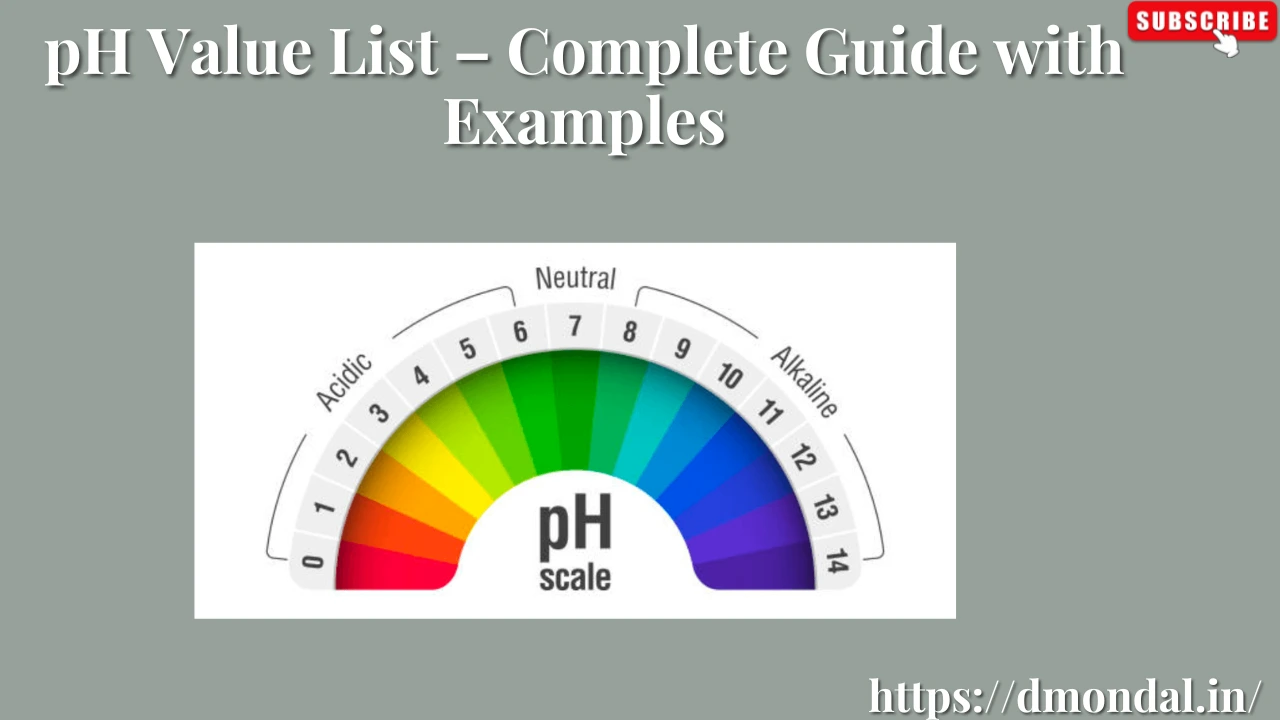pH Value List – Complete Guide with Examples
The pH value is an important measure in chemistry, biology, and everyday life. It tells us whether a substance is acidic, neutral, or alkaline (basic). The pH scale ranges from 0 to 14:
- 0 to 6.9 → Acidic
- 7 → Neutral
- 7.1 to 14 → Alkaline (Basic)
Understanding the pH value list helps in various fields such as medicine, food, water testing, agriculture, and industrial processes.
pH Scale at a Glance
- 0 – 6.9: Acidic (Strong acids closer to 0)
- 7: Neutral (Pure water)
- 7.1 – 14: Alkaline or Basic (Strong bases closer to 14)
pH Value List of Common Substances
| Substance | pH Value | Nature |
|---|---|---|
| Battery Acid (Sulfuric) | 0 | Strong Acid |
| Hydrochloric Acid (HCl) | 1 | Strong Acid |
| Lemon Juice | 2 | Strong Acid |
| Vinegar | 3 | Acidic |
| Orange Juice | 3.5 | Acidic |
| Tomato Juice | 4.2 | Acidic |
| Black Coffee | 5 | Acidic |
| Urine | 6 | Slightly Acidic |
| Milk | 6.5 | Slightly Acidic |
| Pure Water | 7 | Neutral |
| Human Blood | 7.4 | Slightly Alkaline |
| Seawater | 8 | Alkaline |
| Baking Soda Solution | 9 | Alkaline |
| Milk of Magnesia | 10.5 | Alkaline |
| Ammonia Solution | 11 | Strong Base |
| Soapy Water | 12 | Strong Base |
| Bleach (Sodium Hypochlorite) | 13 | Strong Base |
| Drain Cleaner (NaOH) | 14 | Very Strong Base |
Importance of pH Value
- Health & Medicine:
- Human blood must stay between pH 7.35 – 7.45 for survival.
- Stomach acid has low pH for digestion.
- Agriculture:
- Soil pH affects crop growth. Most plants grow best in slightly acidic soil (pH 6–7).
- Water Quality:
- Drinking water should have a pH between 6.5 and 8.5.
- Food & Beverages:
- pH determines taste, preservation, and safety of foods.
pH Scale Diagram (Simple Representation)
Acidic (0) — Neutral (7) — Alkaline (14)
Battery Acid → Lemon → Vinegar → Coffee → Milk → Water → Blood → Baking Soda → Soap → Bleach
Read More: Click here
